Bisotun: Rock Relief and Inscription of the Achaemenids
Kermanshah boasts ancient stone inscriptions and carvings that have stood the test of time, spanning from the Achaemenid period to the present day in a secluded corner of the city.
Among the city's notable landmarks, the historical site of Bisotun has captivated visitors since ancient times. This area has consistently drawn the attention of Iranian kings throughout history, evident in the enduring popularity reflected in both the people and the monarchs of bygone eras.
The origins of this region trace back to the Paleolithic era, featuring caves that bear witness to early human habitation. The Biston inscription, a significant historical artifact, is a prominent feature of this location, attracting numerous tourists to Kermanshah each year.
If you're eager to discover the secrets of this captivating site, read further for a detailed guide of Bisotun.
Historical Timeline of Bisotun
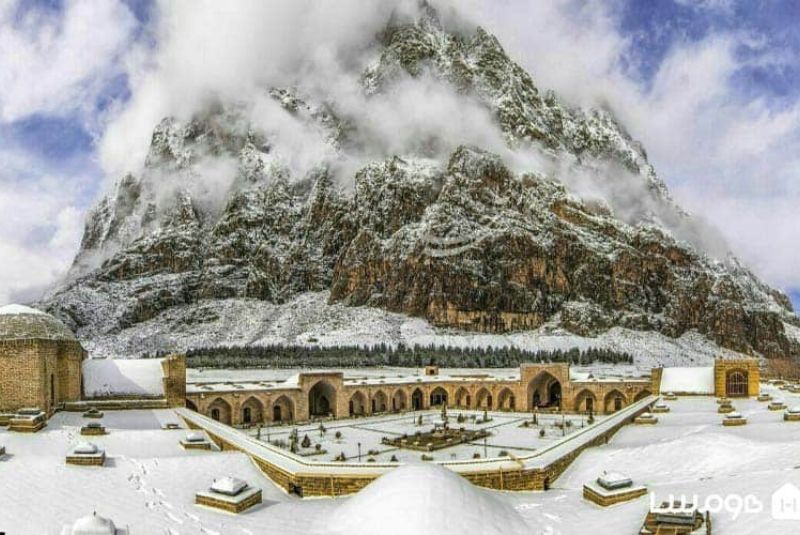
Bisotun, with its ancient roots, holds a rich historical legacy that dates back to various periods. The very name "Bisotun" is derived from the Old Persian term "Bagastana," meaning "the place of the gods." This region has witnessed the passage of time, witnessing the rise and fall of civilizations.
Prehistoric Era:
Evidence suggests that the Bisotun region was inhabited during prehistoric times, with archaeological findings indicating human presence in the area as early as the Paleolithic era.
Achaemenid Empire (6th–4th centuries BCE):
Bisotun gained significant prominence during the reign of Darius the Great, a ruler of the Achaemenid Empire. Darius chose this site for the construction of monumental inscriptions and reliefs that detailed his victories and accomplishments.
Behistun Inscription (522–486 BCE):
The most renowned historical feature of Bisotun is the Behistun Inscription, commissioned by Darius the Great. This trilingual inscription, written in Old Persian, Elamite, and Babylonian, recounts the events surrounding Darius's ascension to the throne and the suppression of rebellions across the empire.
Alexander (4th century BCE):
After Alexander's conquest of Persia, he passed through the Bisotun region. It is said that Alexander's army camped near the Behistun rock, leaving an indelible mark on the history of the site.
Sassanian and Islamic Periods:
During the Sassanian period and the subsequent Islamic era, Bisotun continued to play a role in regional history. The region witnessed cultural exchanges, architectural developments, and the integration of diverse influences.
UNESCO World Heritage Site (2006):
In recognition of its historical and cultural importance, Bisotun was inscribed as a UNESCO World Heritage Site in 2006. This acknowledgment underscores its significance as a global heritage site that deserves preservation and appreciation.
| Related: Taq Bostan - Sassanid Rock Reliefs in Kermanshah, Iran
The Inscriptions of Bisotun

The Behistun Inscription, a monumental masterpiece of ancient Persian art and history, is the focal point of Bisotun. Carved into a towering limestone cliff face, the inscription is a testament to the vision and ambition of Darius the Great.
Situated on the steep face of Mount Behistun, the inscription is strategically positioned along the ancient caravan route connecting Babylon and Ecbatana. The sheer scale of the rock face, reaching a height of approximately 100 meters, adds to the grandeur of the inscriptions.
The Behistun Inscription is composed in three languages: Old Persian, Elamite, and Babylonian. Each version of the text recounts the same historical events, allowing scholars to decipher and cross-reference the inscriptions for a comprehensive understanding.
Surrounding the text are intricate reliefs depicting Darius the Great, the defeated rebels, and divine entities. These artistic elements provide a vivid narrative that complements the written content of the inscriptions.
Commissioned by Darius the Great in the early 5th century BCE, the Behistun Inscription commemorates Darius's rise to power and his successful quelling of multiple revolts across the vast Achaemenid Empire. The inscriptions narrate in detail the events surrounding Darius's ascension to the throne.
| Related: Cyrus The Great – The Most Powerful King in the World
What Does the Bisotun Inscription Say?
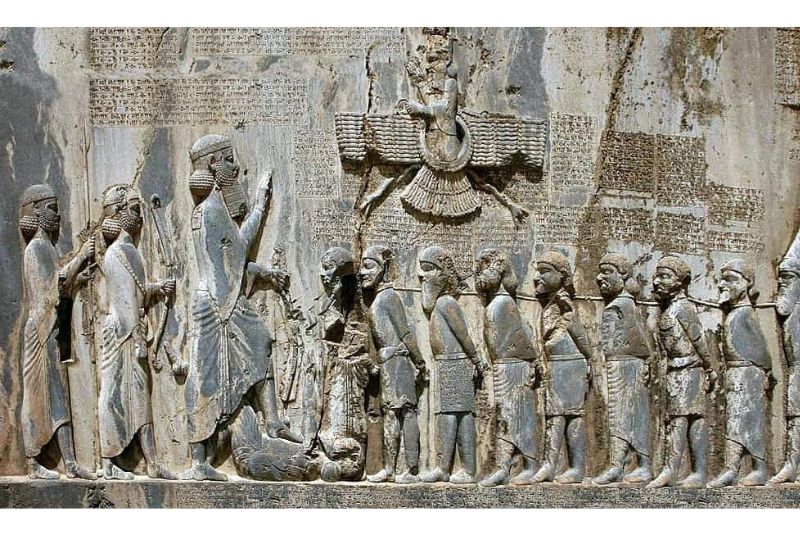
The decipherment of the cuneiform script in the Behistun Inscription is credited to Sir Henry Rawlinson, a British army officer and Orientalist. In the mid-19th century, Rawlinson risked his life to climb the cliff and copy the inscriptions, later using his knowledge of known languages to decipher Old Persian cuneiform.
- The inscription begins with an account of Darius's lineage and his claim to the throne following the death of Cambyses II. It describes how Darius, with the help of the god Ahura Mazda, successfully overcame rival claimants to establish his rule.
- Darius faced a series of revolts across the vast Achaemenid Empire. The inscription details his military campaigns to suppress these rebellions, identifying the rebel leaders and describing the challenges he encountered.
- As Darius traveled to quell the rebellions, the inscription provides geographical and ethnographic details of the regions he traversed. It mentions various peoples, tribes, and locations within the empire.
- One significant rebellion involved a usurper named Gaumata, who claimed to be Bardiya (Smerdis), the brother of Cambyses II. Darius recounts his successful defeat of Gaumata and the restoration of the rightful Achaemenid lineage.
- Throughout the inscription, Darius attributes his success to the support and guidance of the supreme god, Ahura Mazda. The text emphasizes the divine legitimacy of Darius's rule and his adherence to the teachings of Zoroastrianism.
| Discover: Pasargadae - Legacy of Cyrus the Great & Ancient City
Rock Relief and Carvings of Bisotun

The rock relief at Bisotun showcases the artistic mastery of ancient Persian sculptors. The ability to carve intricate details into the unforgiving surface of the cliff reflects a high level of craftsmanship and artistic skill.
The rock relief is strategically positioned near the Behistun Inscription, adding visual depth to the historical narrative carved into the cliff face. The carvings depict both human and divine figures, showcasing the skill of ancient artisans in capturing the nuances of facial expressions, clothing, and symbolic elements.
The central figure in the rock relief is Darius the Great, depicted in a pose that conveys authority and triumph. The carving reinforces the themes presented in the Behistun Inscription, emphasizing Darius's role in overcoming challenges and establishing his rule.
The rock relief incorporates symbols associated with Zoroastrianism, the predominant religion of the Achaemenid Empire. Divine entities, often represented by winged figures, are carved alongside Darius, underscoring the connection between the ruler and the divine order.
| Suggestion: Persepolis City - The Great Ancient Persian Capital
Bisotun Attractions
Bisotun offers a rich blend of natural and historical attractions for visitors. Here's a summary of the notable places to explore in the Bisotun complex:
Statue of Iranian Hercules:

Carved during the Seleucid period, this two-meter-long statue of Iranian Hercules is situated on the slopes of Biston Mountain. The detailed carving depicts Hercules lying on one side, holding a cup and placing the other hand on his leg.
Bisotun Palace:
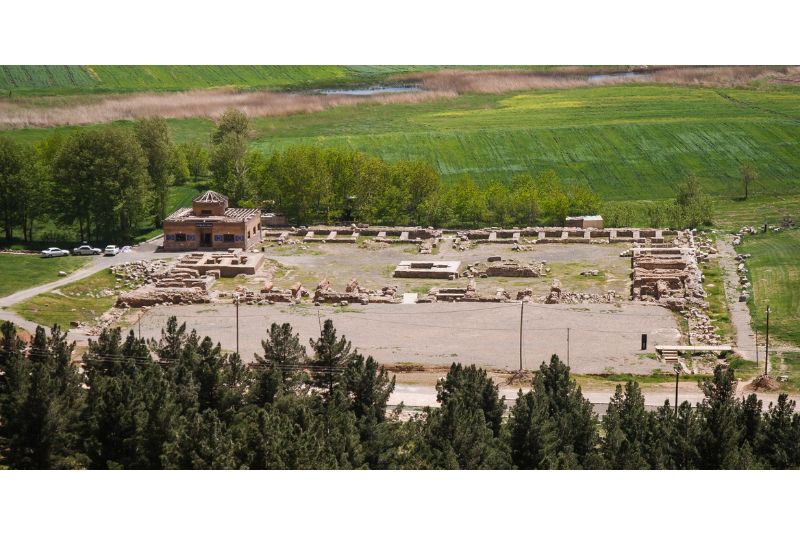
Originally intended to be a palace for Sassanid King, Khosrow Parviz, Biston Palace remains incomplete and partially ruined. It was repurposed as a Ilkhani caravanserai but was later destroyed by an earthquake. The palace was eventually replaced by a village during the Qajar era.
Farhad Tarash (Carved by Farhad)
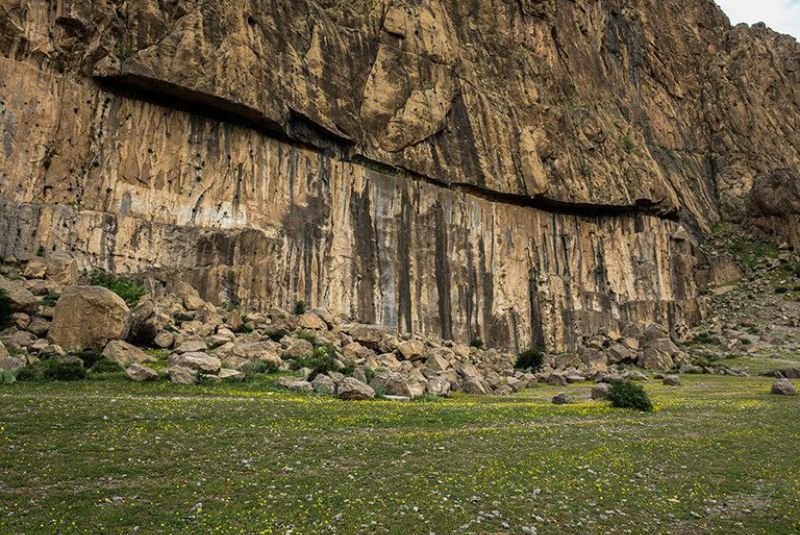
A large wall with a height of about 45 meters and a length of 200 meters, Farhad Tarash belongs to the Sassanian period. The carving tells the tragic love story of Farhad and Shirin, involving Farhad's attempts to dig through Mount Bisotun to reach water, leading to his demise.
| Discover: Frieze of Archers - The Ancient Persian Power
Shah Abbasi Biston Caravanserai:
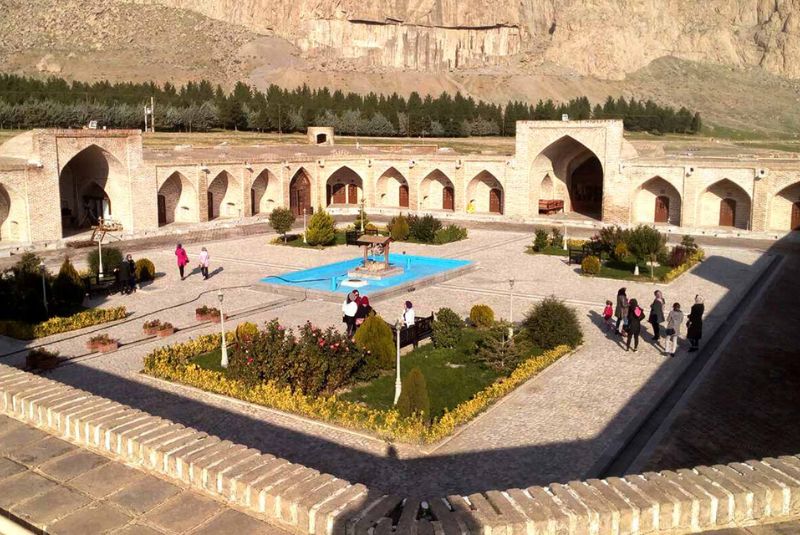
Dating back to the Safavid era, this caravanserai was commissioned by Shah Abbas I. Covering an area of 6000 square meters, it has been transformed into a 5-star hotel with traditional design, welcoming visitors to the Bistun complex.
For the construction of the Shah Abbasi Bistun Caravanserai, materials from the dilapidated Ilkhani Caravanserai were used.
Hunter's Cave:
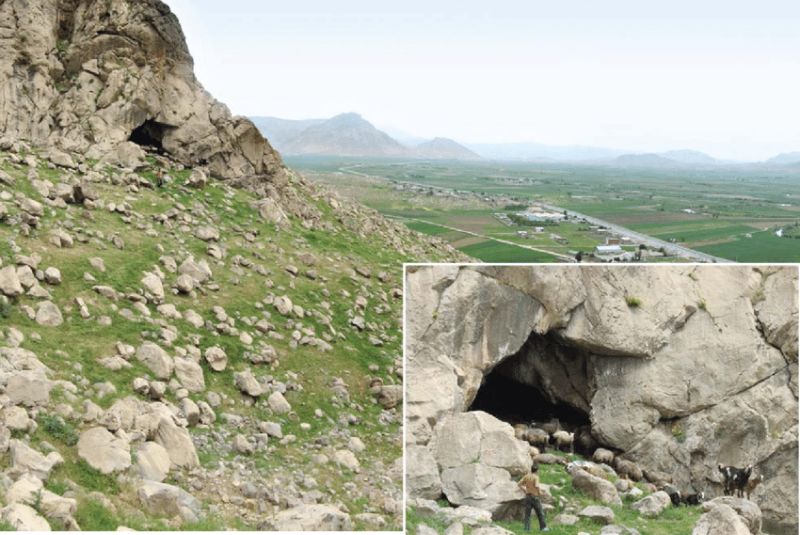
Also known as Bisotun Cave, it likely served as a temporary shelter for hunters. Excavations revealed bones of various animals, including a Neanderthal-type human, dating back 70,000 to 40,000 years.
Mehrdad Ashkani Reliefs:
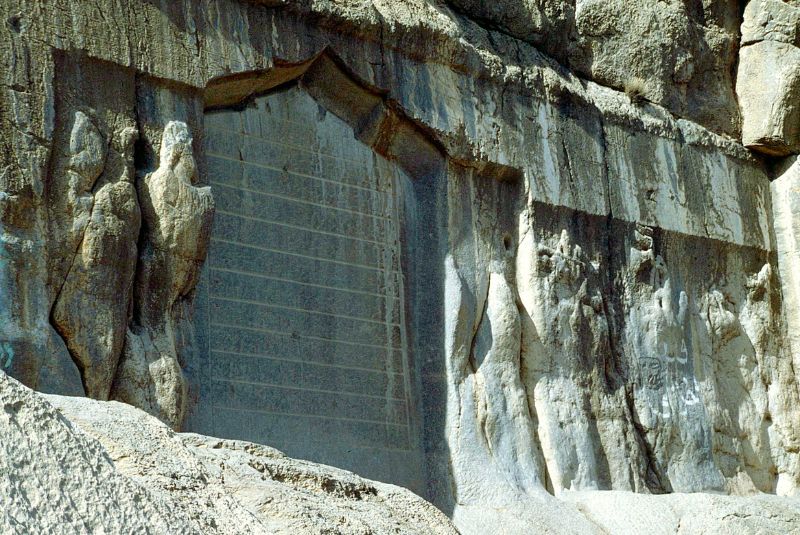
The bas-relief of Mehrdad, a Parthian king, is one of the oldest surviving works from the Parthian era. The relief depicts Mehrdad transferring power to Satraps (local rulers) and has historical significance. The figure has suffered natural damage and deliberate destruction. Situated just beneath the Achaemenid inscription of Darius, this work is believed to have been carved between 123 and 110 BC.
Bisotun Mirage:

This historical spring created a small lake in the Biston area, influencing the establishment and settlement of ancient people. Many valuable historical works around Bisotun were created in proximity to this unique spring.
Khosrow Bridge:
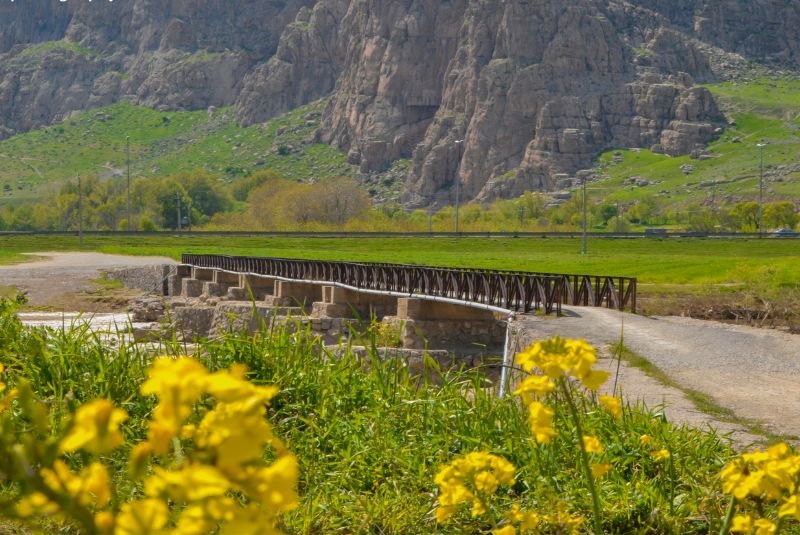
A 150-meter-long and 7-meter-wide bridge located in the southwest of Biston city on the Gamasiab River. Its name and architectural style suggest it was built during the Sassanid period, possibly under Khosrow II.
Bistun Bridge:

A 144-meter-long and 7.6-meter-wide bridge built over the Dinur-Ab River on the old road from Kermanshah to the scene. Its foundations date back to the Sassanid period, with subsequent restoration during the Ilkhanate and Safavid periods.
Median Fortress:
The temple of the Medes in the northwest of the Biston complex, discovered in 1966, features rectangular towers and ramparts constructed with large and small stones in a dry stone style. Its attribution to the Medes period is supported by the discovery of pottery resembling Medes artifacts along with a bronze brooch dating back to the 8th century BC found at the site.
| Suggestion: Sassanid Taq Kasra - World's Largest Single-Span Brick Vault
Best Time to Visit Bisotun

The best time to visit Bistun is during the spring (March to May) and fall (September to November) seasons when the weather is generally mild and pleasant. During these periods, temperatures are moderate, and you can enjoy the outdoor attractions, hiking trails, and cultural sites without the extreme heat of summer or the colder temperatures of winter.
The visiting hours of Bisotun complex start from 8am to 8pm.
Accommodation Options near Bisotun
- Abbasi Caravanserai
- Biston Suite
- Biston Lale Hotel
- Jamshid Hotel
Restaurants near Bisotun
- Biston Nights (Shab-haye Bisotun) Restaurant
- Mirzaei Restaurant
- Kiani Restaurant

Location of Bisotun
The Bistun historical and cultural site is situated 39 kilometers from Kermanshah, located on the slopes of Bistun Mountain in Bistun city. It is conveniently positioned adjacent to the ancient road that connects Kermanshah to Hamadan.
Bottom Line
Recognized as a pivotal historical site in Iran, the Bistun in Kermanshah is distinguished by an array of inscriptions, statues, and reliefs. Venturing into this region offers a journey akin to a compelling history class, where the unfolding narrative is marked by numerous intriguing stories amidst its ups and downs.
If you're planning to explore Iran's attractions, be sure to include a visit to the Bisotun complex in your travel plans for an unforgettable experience.
Share your story!
Comment below and let us know about your Experience.
Your story inspires others!


Comment
Leave a Comment